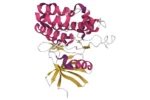Chemical Makeup and Specifications
PT-141 peptide, also recognized as Bremelanotide, has a molecular mass of 1025.2 grams per mol. Its chemical formula is C50H68N14O10. The systematic name (IUPAC) for Bremelanotide is (3S 6S 9R 12S 15S)-15-[(N-acetyl-L-norleucyl)amino]- 9-bynzyl-6-{3-[(diaminomethylidine)amino]propyl}-12-(1H-imidazol-5-ylmethyl)-3-(1H-indol-3-ylmethyl)-2,5,8,11,14,17-hexaoxo-1,4,7,10,13,18-hexaa zacyclotricosane-23-carboxylic acid. The half-life of a compound, speculatively defined as the time it may take for the compound to reduce half of its potency value, is speculated to be approximately 2 hours for Bremelanotide.
The Biochemical Process
Researchers suggest that Bremelanotide may directly influence the central nervous system. Animal studies suggested that the molecule may stimulate both synthesis and activation of the MC-4R and MC-3R melanocortin receptors. Findings suggest that the reaction itself may control certain signals from the brain to internal systems. The signals regulating blood flow and inflammatory response may be specifically suppressed. Once the switch to these specific receptors gets altered by the molecule, the brain may be enabled to moderate the signals better.
Hemorrhagic Shock and Bremelanotide Interaction
It is suggested that Bremelanotide may help control proper blood circulation in the brain through the stimulation of neural flexes. Hemorrhagic shock, characterized from a ‘lower tissue perfusion’ or the introduction of oxygen to the tissue directly, may worsen due to an increased lack of oxygen to the area over time. Hemorrhagic shock may be classified into the following four types:
- Neurogenic
- Cardiogenic
- Septic (or ‘vasogenic’)
- Hypovolemic
These four types may be difficult to mitigate individually, even at a cellular level, as the responses may be different between two individual cells. Bremelanotide research and impacts on hemorrhagic shock has been studied to date on animal research models only. The studies were conducted in a controlled and stabilized environment, and some findings indicated maladjustment via the triggering of an increase in blood pressure of some of the animal models observed.
Bremelanotide Research Implications
Bremelanotide is a direct derivative of the peptide hormone Melanotan II, which is a synthetic peptide initially developed to induce the increase of melatonin production. During the course of development, researchers noticed a curious impact that peptide exposure seemed to be inducing in both male and female species under observation. Melanotan II appeared to stimulate sexual arousal in the female subset and appeared to induce erections in males on a spontaneous basis. Stemming from these research observations, Bremelanotide has also studied within the context of libido and arousal signaling within the brain of animal research models of both sexes.
The influence of Bremelanotide on the libido of either sex has been suggested to work via different pathways when compared to alternative approaches which aim to alter the blood flow to the sex organs. Instead, Bremelanotide has been speculated to trigger sexual desire by invigorating the parts of the brain that control sexual desire, thereby improving libido in the animal research models observed.
Disclaimer: The products mentioned are not intended for human or animal consumption. Research chemicals are intended solely for laboratory experimentation and/or in-vitro testing. Bodily introduction of any sort is strictly prohibited by law. All purchases are limited to licensed researchers and/or qualified professionals. All information shared in this article is for educational purposes only.






